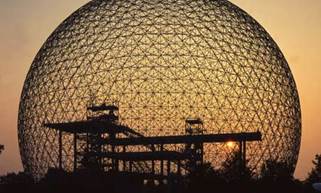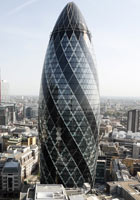Ex. 1. Read the text and pick up difficult or unknown words. Answer the question how N. Foster could express space theme in architecture.
Man on the moon: Norman Foster prepares for architecture's lift-off
When it comes to building on the moon, the British architect has won the scientists' vote. But what might his lunar structures look like?
 A permanent structure on the moon? The dream of building a base on the Moon where astronauts, scientists (and Richard Branson) can study the Earth's most haunting and beautiful satellite is as old and as compelling as the dream of space exploration itself.
A permanent structure on the moon? The dream of building a base on the Moon where astronauts, scientists (and Richard Branson) can study the Earth's most haunting and beautiful satellite is as old and as compelling as the dream of space exploration itself.
Now, the European Space Agency's Aurora program envisages a necklace of such bases strung out across the face of the moon. It's a thrilling thought, but who – which architect – should design the first lunar structures? Why,Norman Foster, of course. Already working on Richard Branson's Virgin Galactic spaceport in New Mexico, due to open in 2011, Foster is the natural – and scientific – choice for such challenging new architecture and habitation. The European Space Agency certainly thinks so, too.
Over several decades, Foster has tried, often successfully, to fuse the materials, technology, forms and spirit of space adventure into the design of his world-renowned hi-tech buildings. Arguably more than any other architect, Foster has brought the world of Nasa into our towns, cities and university campuses – whether with the design of the gleaming Sainsbury Centre for Visual Arts at the University of East Anglia, on the edge of Norwich, or with the very shape, as well as the structure, of the Swiss Re building, better know as the Gherkin, in the heart of London. This skyscraper – it looks nothing like a gherkin – even resembles a space-rocket.
 The Swiss Re tower (Gherkin) in London
The Swiss Re tower (Gherkin) in London
Moon bases, however, are unlikely to resemble skyscrapers, not even those by Norman Foster. They are far more likely to adopt the forms and structure of the famous geodesic domes popularised by the American designer Buckminster Fuller and invented by the German engineer Walther Bauersfeld with the1923 planetarium in Jena, Germany. With his first vinyl-skinned geodesic dome, built in 1949 from aluminium aircraft tubing, Fuller demonstrated that such a building could bear its own weight even if stretched as far as it was humanly possible. In other words, here was a supremely light, supremely strong domed structure that would, in all likelihood, make a good moon base. In his later years, Fuller was a frequent and influential presence in Norman Foster's London studio.
While medieval cathedrals certainly soared heavenwards, buildings that were first described as being a part of the space age emerged only after the first world war when the study of rocketry and space travel was developing apace, notably in Germany. It was in Potsdam that the Prussian architect, Erich Mendelsohn, built his Einstein Tower, a solar laboratory and astronomical observatory opened in 1924 and still in use today. Its curious organic form was like nothing else at the time of its construction; it was, though, referred to on a number of occasions as being like a "spaceship" – an "ungainly" one at that.
What we think of as space-age architecture only really emerged in the 1960s, at a time when the Gemini and Apollo space missions had captured the public – and professional – imagination. The British architectural group Archigram drew and made models of an entertaining and provocative range of space-age structures and habitats, from one-person survival pods to plug-in and walking cities that would have made wonderful illustrations for science-fiction comics and novels. With an understanding of newly available materials and technologies, Archigram's designs for capsules, living pods and "cuishicles" (balloon-like pods) were both instructive and entertaining, and gave a hint of what life in space-age habitats and structures might be like.
Back on the ground, Britain's "hi-tech" architects of the 1970s and 80s – Norman Foster, Richard Rogers, Michael Hopkins and Nicholas Grimshaw – made bold plays with the latest materials and building technologies. If not suitable for life on the moon, their buildings sometimes looked like nothing else on Earth. Just look at the Pompidou Centre.
More recently, Grimshaw's Eden Project, Cornwall, really does look and feel like a habitat, or bubble city, from another planet. Its soap-sud-like structure is very much the stuff of science-fact rather than fiction; here is a sequence of giant pods foaming up from fissures in rocks and protecting and nurturing plant life drawn from all over the world.
Foster's aesthetic has always tended towards that of Stanley Kubrick's film 2001: A Space Odyssey, which is what most of us might expect structures on the moon to be like – reassuringly technical, graceful, silver, white and immaculate. Experiments with eco-friendly "earthships" in the US, however, used as testbeds for living on the moon, Mars and beyond, have been much earthier places to be than Kubrick's, with these structures looking and feeling more like greenhouses than sleek space hotels. But then, as there will be a desire to grow food on the moon as well as to produce water, however possible, a kind of greenhouse-like geodesic dome is one way forward. Given that Foster has already designed hi-tech buildings featuring internal gardens – the Commerzbank in Frankfurt and London's Swiss Re tower – he is quite aware of how nature and space-age technology can, and might, co-exist.
